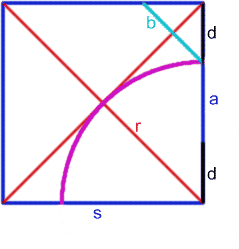Copyright © University of Cambridge. All rights reserved.
'The Medieval Octagon' printed from https://nrich.maths.org/
Show menu
Solution by: Andrew Ross from Dr. Challoner's Grammar School

Call the side length of the square $s$. Use the diagram for other lengths.
The octagon has side lengths $a$ and $b$.
By Pythagoras' Theorem: $$r = {s\sqrt 2\over 2}$$ Because $s = r + d$ so $$d = s(1 - {\sqrt 2 \over 2}).$$ One side of the octagon is given by: $$a = s - 2d = s - 2s(1 - {\sqrt 2 \over 2}) = s(\sqrt 2 - 1).$$ By Pythagoras' Theorem $ b^2 = 2 d^2$ so $b = d \sqrt 2$. Hence $$b = s\sqrt 2 (1 - {\sqrt 2 \over 2}) = s(\sqrt 2 - 1) = a.$$ The octagon has rotational symmetry of order 4 as it was constructed from a square and all the sides are the same length, so it is a regular octagon.